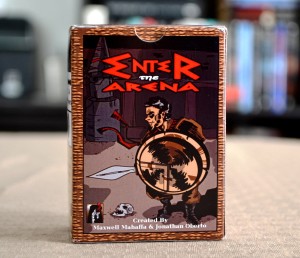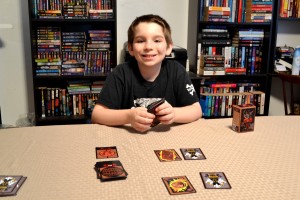As bloody as movies like “Gladiator” and games like “Chivalry: Medieval Warfare” are, I find myself oddly drawn to them…there’s just something about a good, old-fashioned last man standing brawl that gets the adrenaline pumping. When I was a kid, I’d spend hours at the arcade playing “WWF Royal Rumble” for that very reason. “ETA: Enter The Arena”, a game currently seeking your help on Kickstarter, is a competitive card game that takes place during the days of the Roman Empire. Each player will be given a set of cards and will be aiming to not only beat their opponents silly, but do it with “style”. Before we take a look at this current Kickstarter project (as of 9/30/13), I’d like to thank Jonathan Oberto from Promethean Games Inc. for providing me with a press copy. It’s important to stress that because the game is still in the Kickstarter stage, that the components featured below may or may not be fully representative of the final product.
*Note: 5-8 players can play with the Battle Royal Package.
The game itself comes with a variety of different cards, ranging from attack and defense cards to style and event cards. Now I know what you’re thinking…simulating melee combat with cards can sound both complicated and dull. I’m pleased to report that neither was the case and I especially liked the fact that the game was incredibly easy to pick up and play. After a game or two, you’ll be able to bust out a game in ten minutes if you manage to keep the game flowing. This is assuming of course that all of the players know what they’re doing…though you won’t have to wait long if they don’t.
At the beginning of the game, each player will receive the same preset deck of cards. This ensures that everyone will start off on equal footing. A player’s deck/hand will initially consist of attack, defense, and style cards…though as cards are used, a player’s hand will dwindle until they have nothing left. I found that this forced us to give real thought into the cards we played. Playing all of your higher attack or defense cards in the beginning, for example, might leave you helpless a few turns down the line. Once a player’s hand runs out, they’ll simply shuffle their discard pile and start anew.
A game turn is fairly straight forward. Each player will place either an attack or defense card face down on the table, starting with the round leader going clockwise. The round leader card will move around the board in the same fashion at the end of every round, ensuring that other players have an equal chance of going first. Once all players have played an attack or defense card, they’ll reveal them in the same order. When a player does so, they’ll have the option to augment their attack/defense card with a style card and/or play an event card. Depending on what cards are played, players will lose health and gain style points appropriately when the round ends.
Attack and defense cards come in values of either one, two, or three. The higher the number, the more powerful the card. In the event that players simply play these cards without involving style cards, the values are compared and those with attack values higher than their chosen target’s defense value, do damage equal to the difference. If “Player A” played an attack card of three and chose to attack “Player C” who played a defense card of two, “Player C” would lose one health. Players who lose all of their health are eliminated from the game. Consequently, this is one of the ways a player can win…that is, be the last one standing.
Style cards provide players with a separate point pool, giving players more than one way to win the game. While eliminating all of the other players from the game would make victory all the more sweeter, you can also win by gaining a total of twelve style points. If players can properly defend without taking damage or perform a successful attack on another player when playing a style card, they’ll be able to add style points to their pool. This can be risky, as a failed style card play can actually reward your opponent with style points instead.
When you’re playing with just two players, play can be somewhat predictable. Having a third or fourth body really adds a bit more strategy to the game, as you’ll need to choose who you’ll want to attack. Counting the cards played by your opponent(s) also becomes more difficult as you add more players to the mix. Event cards, which are special one time bonus cards that can be used to turn the tide of battle, do add a bit of variety to the battle. They are gained when earning style points, so players will need to pay attention to what’s being played if they want to get their hands on them.
In the end, “ETA: Enter The Arena” is a quick and dirty solution for when you have that “battle your friends” itch. The gameplay elements are sound, not to mention extremely easy to learn. The age requirement could stand to be flexible for this very reason, though parents will have to take into account the violent theme. While the art isn’t overly graphic, younger kids who still struggle between fantasy violence and reality violence should probably pass on this. I had no issues with letting Vinnie (12) play the game, who by the way, proceeded to hand me my proverbial behind. Strategic and fun to play, “ETA: Enter The Arena” is worth checking out.
—
You can learn more about and support “ETA: Enter The Arena” by visiting the following website:
http://www.kickstarter.com/projects/prometheangames/eta-enter-the-arena
http://boardgamegeek.com/boardgame/148123/enter-the-arena
—



Super excited for this game to come out! I like games where I get to stab people in the back 😉
I am so backing this project =)